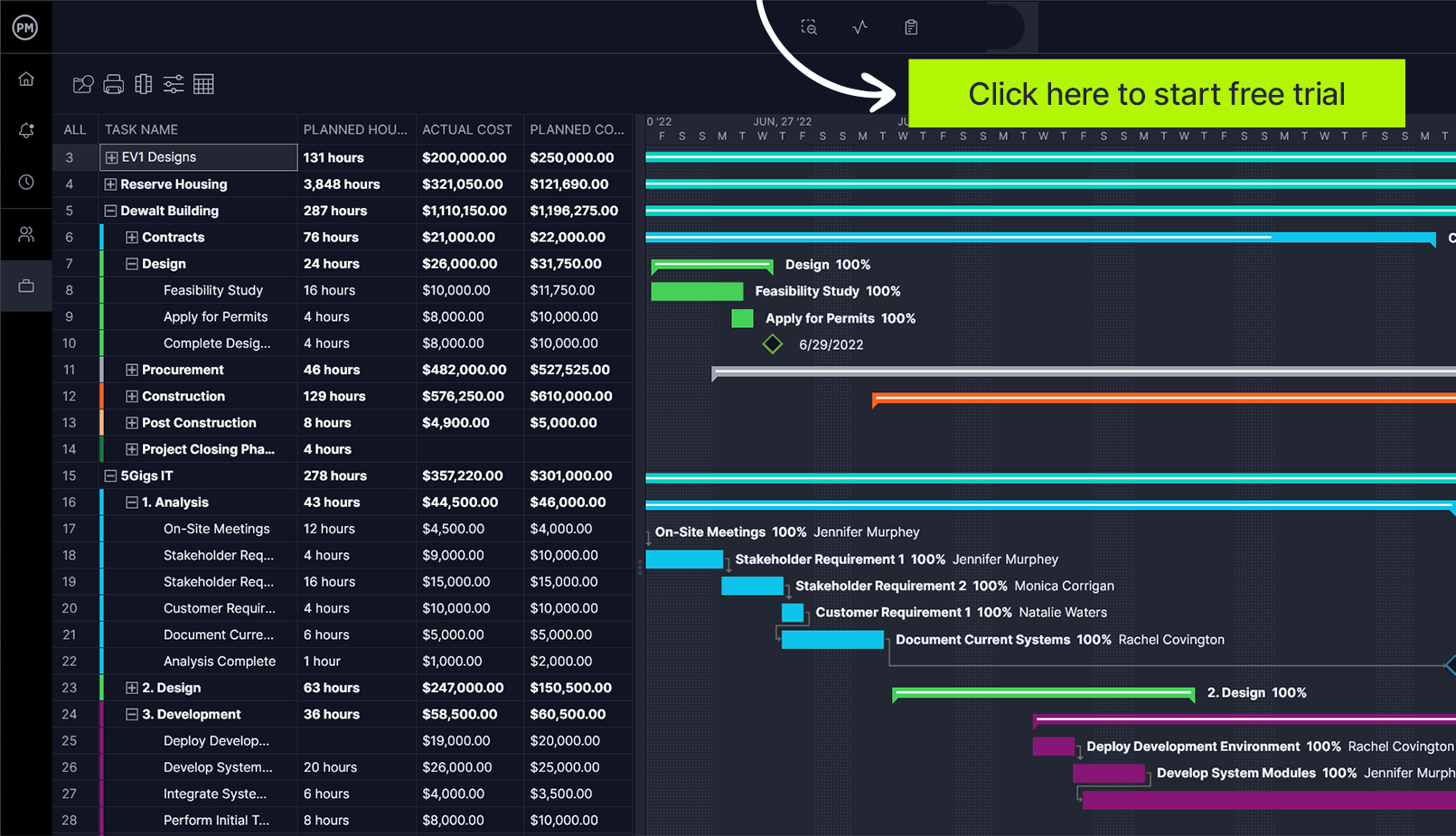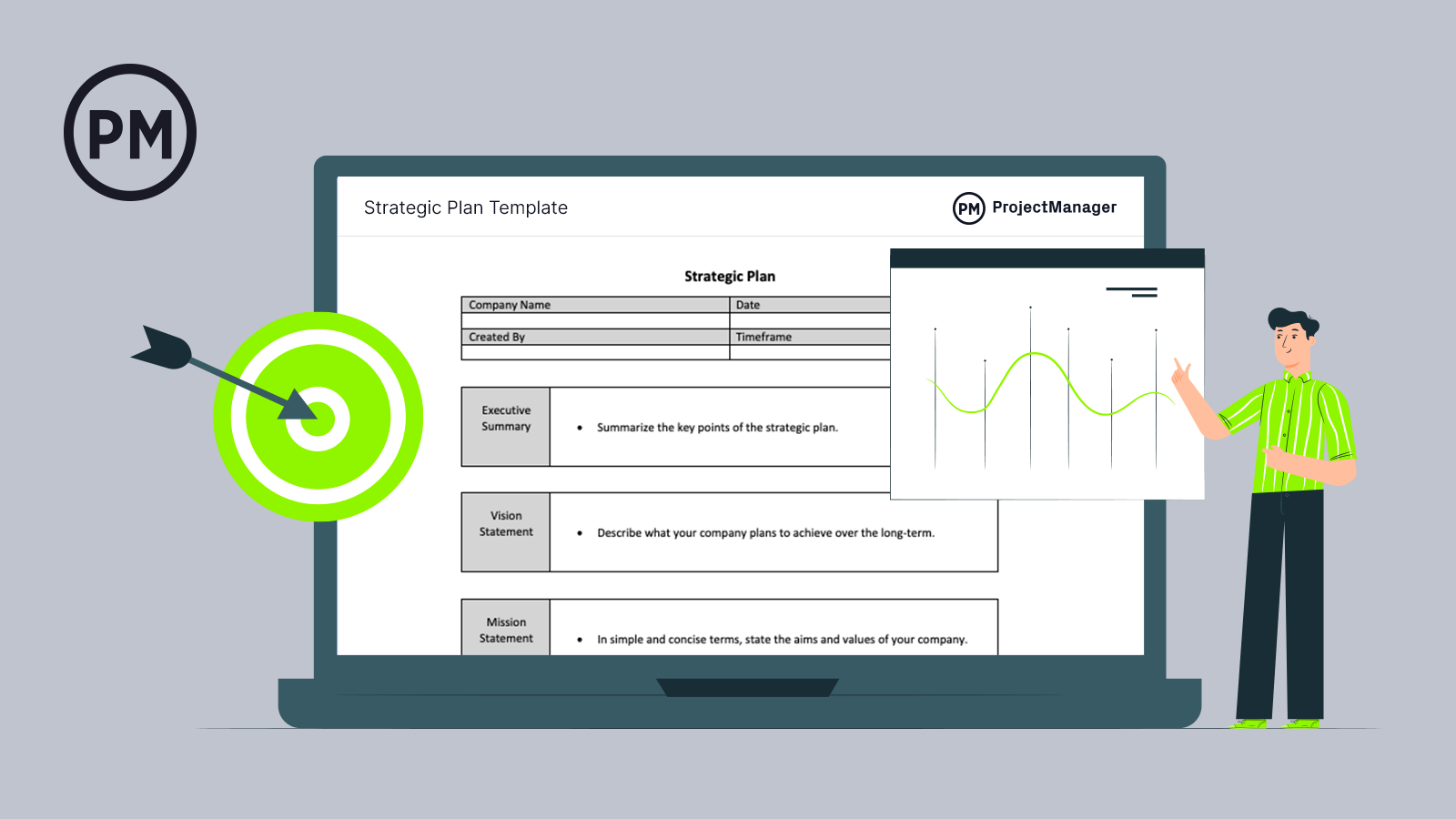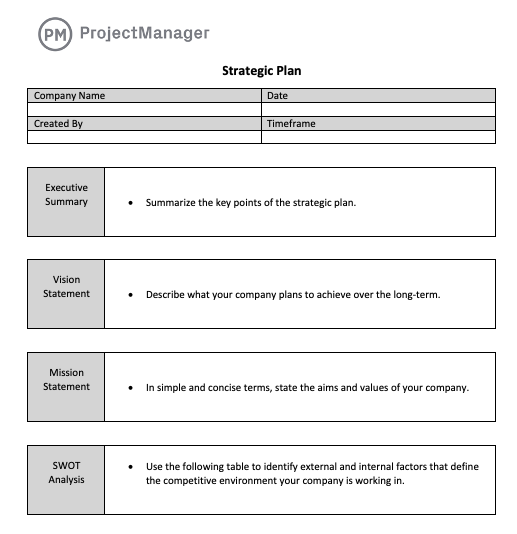Projects are often viewed as standalone events. They are, after all, temporary and create a deliverable when completed. But this is a short-sided view that misses the big picture. Projects are often part of an organization’s larger goals and objectives. Strategic project management understands this.
If you haven’t heard the term before, we’ll begin with a definition of strategic project management and explain how strategic projects differ from operational projects. We’ll also outline the roles of those involved in strategic project management as well as best practices to help you align projects with business strategy.
What Is Strategic Project Management?
Strategic project management looks at individual projects and how they can potentially benefit a company. This can be either by adding efficiency to the company’s operations or aligning with its strategic plan. It views a project through the lens of how it connects to the overall strategic plan of the company.
Therefore, the project has a goal, but that goal should also fit into the company’s strategy for success, growth and so forth. This is something that should be thought of when working on big or small projects. A company’s portfolio of projects should all work together to serve the needs of the company.
Usually, companies have a project management office (PMO) that will oversee the portfolio or program to ensure it meets strategic goals. They’ll decide if the mix of projects is appropriate or sufficient to deliver on the company’s strategic goals, whether there are the resources to accomplish this, if the right projects are being prioritized and if there is the flexibility to adjust to changes in scheduling or resources.
Project management software can help to manage your projects to meet their goals and the larger ones of the company. ProjectManager is award-winning project management software with powerful project portfolio roadmaps that collect all your projects and display them on a Gantt chart. Allocate resources, track time and manage tasks all from one screen. Users can filter the roadmap by assignee, project manager or customer to make forecasts, view who’s assigned to tasks and get key metrics to make more insightful decisions. Get started with ProjectManager today for free.

Examples of Strategic Projects
Let’s imagine a highly successful manufacturing business that has two key strategic objectives outlined in its strategic plan. First, the company plans on opening new brick-and-mortar stores. And second, the company plans on selling its products online in the upcoming year.
These are strategic goals that require the execution of the following strategic projects:
- Create a website and mobile app to sell products online.
- Develop marketing strategies to promote the new stores, website and app.
- Hire new staff and train current staff on new guidelines and procedures for online sales.
- Build a new production facility and acquire machinery and equipment to increase its production capacity to keep up with the increasing demand.
- Build new production warehouses and distribution centers to expand its storage and distribution capabilities.
- Establish a logistics management framework for processing online orders.
- Find new raw material suppliers to avoid any shortages in the supply chain.
As you can see, these projects are aligned with both of the strategic goals of the company and work cohesively together to achieve them.
Strategic Projects vs. Operational Projects
Are all projects strategic? Not necessarily. A strategic project is connected to a company’s larger strategic plan. That could be to expand its market share by introducing a new product to the marketplace. The project that develops, manufactures and delivers that new product is strategic, even though it has its own unique goals.
But some projects are what is called operational. An operational project is essential for the day-to-day functioning of the company. It may or may not directly impact the strategic goals of that company. For example, some operational projects include routine maintenance, training programs, upgrades to IT infrastructure, etc.

Get your free
Strategic Plan Template
Use this free Strategic Plan Template for Word to manage your projects better.
Strategic Project Management Roles & Responsibilities
Understanding strategic project management is more than just defining the term. It’s important to know the roles and responsibilities of those who are involved in implementing it for the company. These are high-level positions for people who already are tasked with managing projects, programs and portfolios as well as the aforementioned PMO. Let’s take a moment to define these positions.
Project Management Office (PMO)
A PMO is an internal or external group, agency or department that’s responsible for defining and maintaining the standards of project management for a company. In that regard, the project management office prioritizes projects, establishes project governance guidelines and groups projects into programs to achieve benefits for the company and align projects with the company’s culture and strategy effectively.
Project Manager
A project manager is usually only responsible for one project. They’ll lead that project in planning, executing, monitoring and controlling as well as closing the project. They manage the team who executes the tasks of the project. The main role of a project manager is to deliver the project on time, within budget and meeting quality expectations. However, with strategic projects, they’ll be aware of the long-term and strategic alignment of the project they’re managing to the company’s goals and objectives.
Program Manager
A program manager is a more strategic role than a project manager. They’re responsible for the strategic project management of a program, which is a group of related projects. Therefore, they oversee the delivery of organizational goals, coordinating activity between multiple projects without directly managing them. However, they do manage the larger program to ensure it’s meeting strategic goals.
Portfolio Manager
The portfolio manager is closer to the program manager than the project manager in that they are managing a portfolio of projects and are responsible for the larger organizational goals of the company. The major difference between the two is that the program manager is working with a group of related projects. They both are thinking of strategic alliances with the company’s goals and objectives.
Strategic Plan Template
The first step in strategic project management is to understand the strategic plan of your organization, so you can better assess the impact that projects have in the completion of its larger strategic objectives. This free strategic plan template for Word can help you gather some of the most important aspects of your strategic plan such as timelines, budgets and resources.

Strategic Project Management Best Practices
Now that we understand the concept behind strategic project management and the people involved in the project, the next step is to look at the best ways to implement your project strategy. The following are several tips that’ll help you make sure that your strategic projects are aligned with your company’s overall strategic goals.
Setup a PMO
If you don’t have a PMO, then you’ll want one. It’ll allow you to create and keep the project management standards that are important to you, such as making sure strategic projects align with company goals. It will also take a high-level view of all your strategic projects and allocate resources wisely to deliver the company’s strategic goals.
Track Projects Closely
A big part of strategic project management is tracking project metrics. The only way to know if projects are performing as planned is to monitor them and track essential metrics, such as costs, timelines, budgets and other performance metrics.
Determine the Feasibility of Projects and Programs
Before you initiate a project, you have to make sure that it’s viable and aligns with your company’s strategic goals and objectives. Every project should have a feasibility study, too. That will determine if the project fits into the larger strategy of the company as well as if it’s worth pursuing.
Estimate the Return on Investment of Projects and Programs
Being able to forecast the value of a project or program before approving it will help you avoid costly losses. There are several ways to go about doing this. One is a cost-benefit analysis, which determines if the investment is worth the beneficial outcome.
Evaluate Capital Budgeting Decisions Carefully
It’s essential to think of capital budgeting when making decisions about which projects to approve. Capital budgeting is one way businesses evaluate the potential profitability of new projects by creating accountability and measurability. This allows a business to understand the risks and returns involved in choosing a strategic project.
Conduct a Cost-Benefit Analysis
We’ve already mentioned a cost-benefit analysis, but it’s worth repeating as it’s such an important step in deciding which strategic project is right for the company. This process allows one to measure the benefits of a project and subtract the costs associated with the project to provide a clear picture of its value. This can be then compared to the overall strategic goals of the company to ensure they’re in sync.
Understand the Enterprise Environmental Factors That Surround Your Projects and Programs
One thing that can be tricky when trying to decide on which project is a strategic fit for the company is the environment in which it’ll take place. Projects that share objectives and work scopes are going to differ in the environments in which they’re executed. These environmental factors, such as market conditions, legal restrictions, government or industry standards, can impact the success or failure of the project.

How ProjectManager Helps With Strategic Project Management
Another best practice for strategic project management is the use of project management software to ensure they’re aligned with larger strategic goals. ProjectManager is award-winning project management software that has features to plan, manage and track strategic projects in real time. Live data helps you quickly determine how your projects are performing so you can make data-driven decisions to keep them aligned with the company’s goals and objectives. Users are always notified when there are any changes or comments, both by email and in-app alerts to facilitate collaboration. Our unlimited file storage turns the tool into a centralized hub for all your projects’ documentation. But that’s only the start.
Monitor Projects With Portfolio Dashboards
Once you’ve chosen a project as a strategic fit for the company, you have to make sure it follows the plan and delivers on that promise. Our real-time portfolio dashboards give you a high-level overview of all your projects in one place with easy-to-read graphs and charts that track cost, progress and more. Portfolio dashboards can be customized to match your process. Best of all, unlike lightweight alternatives, our dashboard doesn’t require a lengthy and complicated setup. It’s ready when you are.

Get Customized Portfolio Reports
When you need to go deeper into the data, toggle over to our reporting features. Here you can find several reports, including portfolio status, which can be generated quickly. Every report can be filtered to focus on only the date you’re most interested in, such as status, customer, priority and more. Reports are also a great way to keep the executive team updated on strategic projects. They can be shared across a variety of formats and delivered to stakeholders during project presentations.

Our software has other tools to help track time and teams. Use our secure timesheets to track the time your teams spend on their tasks to keep resource costs aligned with your budget and get value data on team performance to improve productivity. For better security, we offer single sign-on to make it easier to change passwords and protect your data. Plus, risk management tools help you control unexpected events to deliver projects on time without overspending.
Related Content
- Strategic Planning in Business
- Strategic Planning Models: An Introduction to 5 Popular Models
- A Quick Guide to Strategic Initiatives
- How to Create a Strategic Roadmap for Your Organization
- Strategic Plan Template
- Project Alignment: Aligning Your Project to Business Strategy
ProjectManager is cloud-based project management software that connects teams in the office, out in the field and anywhere in the world. They can share files, comment at the task level and more to foster greater collaboration. Join teams at Avis, Nestle and Siemens who use our software to succeed. Get started with ProjectManager today for free.


